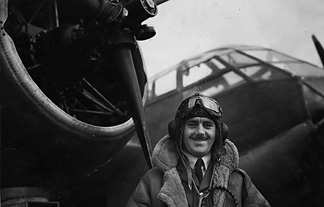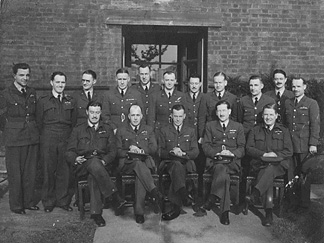 |
 |
||||
|
563637 Pearson RW, Sgt, RAF “F/O “Twinkle” Pearson, an ex-Sergeant pilot, was one of the happiest and cheeriest members of the Squadron. You could never get “Twinkle” down. Short, stocky, and always smiling, he was one of 211’s most experienced pilots. “Potato” and he had been in the same crew when the RAF first had Heyfords—the “Haybag” that was once described as the aircraft with the built-in head-wind—and now they flew together in the same Flight.” So war correspondent TH Wisdom introduced Flying Officer Ronald William Pearson in Wings Over Olympus, filling in some detail of the service of Flight Lieutenant GD “Potato” Jones to boot. Pearson was indeed an old hand by 1940. A Blenheim pilot of 211 Squadron in the Western Desert and Greece, he had joined the Squadron within a week of its re-forming in the Summer of 1937, at Mildenhall, to fly two-seat Hawker Audax and then Hind day-bombers.
With the official BAFG Press Office stamp on the rear, quite possibly another of Fogplate Hensser’s large format photographs shot in Greece. He and Tommy Wisdom worked closely on assignment to France, then Egypt, the Middle East and Greece. Here “Twinkle” beams at the photographer, in full flying kit, with Mark I at rest, on a dull day “somewhere in Greece” as they were wont to say. Very probably Menidi (Tatoi), Hensser having taken a number of well-known shots there in early 1941. An old hand in the making Remustering for aircrew training well before the war, Pearson had qualified as a Sergeant Pilot in time to fly the last of the great biplane night-bombers, the Handley Page Type 50 Heyford, with GD “Potato” Jones in 97 Squadron in 1936 or 1937. Just when Graham Danson Jones 37265 was given the nickname “Potato” is not recorded, but there were numerous Jones boys in the Service: they drew a rich assortment of distinguishing names, either by Service nick-name tradition or more prosaically by surname hyphenation. In April 1937, one Cpt DJ Jones of Wales had set out with his tramp steamer Marie Llewellyn and a cargo ostensibly of potatoes, to break Fascist General Franco’s blockade of Republican-held Spain in the Civil War. For his actions, her captain became a cause celebre of the day, known thereafter as “Potato” Jones . Graham Jones himself had joined the RAF in September 1935. Posted to 97 (Straits Settlements) Squadron in August 1936, he was a Pilot Officer, flying their assortment of Heyford night-bombers of various Marks around Wiltshire and Yorkshire. Posted in to a rapidly growing 211 Squadron from 97 Squadron the day after Sgt Pearson in July 1937, Jones was made ‘A’ Flight commander a week later. Made Flying Officer in 1938, he was ‘C’ Flight commander from June 1938. He, too, became an old hand. Awarded the DFC in February 1941 he had by then recorded over 40 ops with the Greyhounds. He survived Greece and returned to the UK in 1942, to command of 97 Squadron, by then a Lancaster unit. Awarded the DSO in July 1943, he survived the war to retire from the RAF a Group Captain in 1958. Although NCOs were not often noted by name then, the Squadron record for 1 July 1937 noted the arrival of Pearson briefly: “posted to squadron [...] also Sgt Pilot R.W. PEARSON from service squadron.” In those early days, the Orderly Room didn’t even possess a typewriter, so the Form 540s were all handwritten and the entries brief. However, from a transcript of his Flying Log Book, he took part in the usual formation and bombing exercises, flying their Hawker Hinds. To the Middle East and so to War From Daba and nearby Qotafiya, the Squadron applied itself to attacking Italian forces in Libya, and as they later advanced into Egypt along the coast road. Although part of the Squadron record is incomplete for June, from that and a partial transcript of his Flying Log Book, Pearson had flown on at least 27 sorties by the end of October 1940. They moved to Greece in November, one of the handful of Squadrons that made up British Air Forces Greece, all that the could be spared from the hard-pressed RAF ME force of ACM Longmore. From Menidi on the outskirts of Athens they set about attacking the Italian supply lines, among their targets the Albanian ports of Durazzo and Valona. Their route took them North West from Athens in Winter weather, over the mountainous terrain of the Epirus and the Pindus ranges, some 250 or 300 miles direct to reach their targets in Italian annexed Albania, sometimes via Larissa to refuel if heading for Durazzo, sometimes to turn back because of poor weather and, frustratingly, sometimes returning as ordered for lack of cloud cover, sometimes now taking the loss of old friends.
Either the aircraft call-letter ‘U’ or possibly the first letter of the Squadron UQ code in shot. Plainly a Blenheim I, under tow across a flower-strewn grass surface. There are quite a number of buildings in the background, one of them a large hangar. Another large format photograph, taken from an interesting angle, possibly another official press shot though without the usual stamp on the rear. Plainly not at rustic Paramythia, this evocative scene may well be at Menidi (Tatoi) in early 1941, although topographically it might just be Elevsis, where 211 occasionally called. In late January they moved North West to Paramythia, much closer to the action. Pearson remained as cheerful as ever: “Twinkle put up a great show next day [16 March 1941], and as a result had a strip torn off for him by “the Bish”. With 55 raids on his log-book, and feeling rather pleased with himself, he was returning from an important reconnaissance. Over the sea, and not far from our favourite target, Valona, he came across a Cant 506b, an Italian three-engined float plane much used for reconnaissance and “hit and run” raids on undefended Greek villages. And, of course, he went in at once to the attack. When he landed and walked across to the Mess, looking most fed-up, he was greeted with cries of “Drinks on you!” He did not know he had been successful in shooting down the Cant, for he had had to break off the combat while the Italian was still in the air, though obviously crippled. A Greek observer on the coast had watched the flight, and had seen, after “Twinkle” had left, the Italian crash into the sea and sink. He rang up Headquarters and they passed on the news before “Twinkle” had landed. He was then all smiles, though “the Bish” told him sternly not to fool about in future, when he was returning from a special job. But “the Bish” was just as pleased as the rest of us. The story of his attack is in the best traditions. He told us: “We were evenly enough matched - the Blenheim had two guns and the Cant had three, two in the rear turrets and one front. We tackled first the stings in the tail, and with my second burst I got the rear gunner. Just in time, too, for the tracer from the top turret was fairly whizzing past the cockpit - most unpleasant. Then, the rear guns silenced, I went for the cockpit, and made a series of head-on attacks to drive him away from home. When the “ammo” in the front gun was exhausted we tried beam attacks to give my rear-gunner a chance. It was jolly good fun. Then we had to come back, regretfully, for the Cant, just above the waves, was still flying, though all his guns were silent. So we landed a little fed up.” In these conditions, Pearson, usually with Sgts Riddle and Chignall, flew on at least another 25 ops before the Squadron was overwhelmed by the German offensive of Spring 1941, losing not one but two COs in the process. He was awarded the DFC in April 1941, shortly before the Easter Sunday disaster, on which he was not called to fly. The Air Ministry bulletin citation remarked: “Operating continuously from Egypt and Greece since the outbreak of the War with Italy, this officer has carried out 45 operational sorties, on many occasions leading a flight against the enemy. Throughout, he has shown courage and devotion to duty in the face of AA fire and fighter attack. Recently he carried out 8 sorties in 8 days, including hazardous photographic reconnaissances.” Taking part in the evacuation from Greece, the Squadron withdrew via Crete and by the end of April was re-gathering its strength in Palestine for the short but bitter little struggles of May with the Vichy French in Syria and the pro-Fascist warlord Raschid Ali of Iraq. Gazetted as Flying Officer in July 1941, Pearson’s time with 211 Squadron was coming to an end. Screened
Pearson second from the left, standing. Among the 16 men there are at least seven Pilots (one a Sergeant), one Observer and a number of men senior in years and/or rank, a number of them non-flying. The three central seated figures are a Squadron Leader (left) and two Wing Commanders (one, non-flying, centre). Although said to be The Squadron 1941, sadly not 211 Squadron and not Greece, Pearson being the only recognisable man. Taken in the UK at an older, permanent RAF station of pre-war build, “Twinkle” has the two rings of his rank (gazetted in June 1942) and two ribbons, one the DFC he was awarded in April 1941, the other either the 1939—1943 Star or the Africa Star, their ribbons being issued from mid 1943. The War Service Dress battledress jacket (worn by aircrew from 1940) apparently extended to non-aircrew in 1943 (leftmost seated officer) while the wearing of VR gilt in officer's lapels, seen in several of these men, apparently notionally ceased in June 1943. Possibly Kemble, therefore, and most likely Summer 1943. Sadly, F/Lt RW Pearson’s luck had now run out. On 7 August 1943, he was air testing new Hurricane IIC LD159 over Kemble airfield, when the aircraft stalled at low level, crashing just outside the boundary. “Twinkle”, decorated veteran of the Desert and Greece, was no more, dead at the age of 30. They laid him to rest in Kemble Church Cemetery. Service remembered For my own contribution, in addition to drawing upon my own copies of Squadron and other records, official and otherwise, I must thank my old friend Ian Carter and through him, the Pearson family, for access to (and permission to use) personal records and images; RAF Halton Apprentices Association archivist Derek “Min” Larkin for early service information; and Graham Pitchfork for details of the 1943 accident. In Memory of Sources Carter, Pitchfork, Grierson: personal correspondence with author Air Ministry Air Force List 1936, 1937, 1939, 1942 (HMSO)
www.211squadron.org © D Clark & others 1998—2025 |
||||


